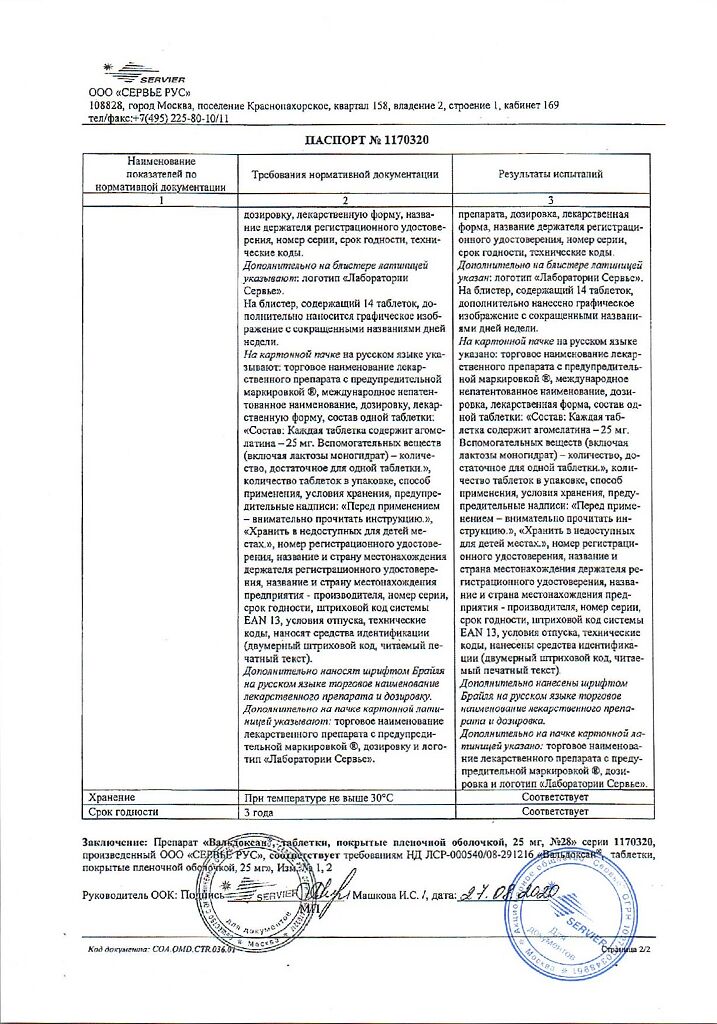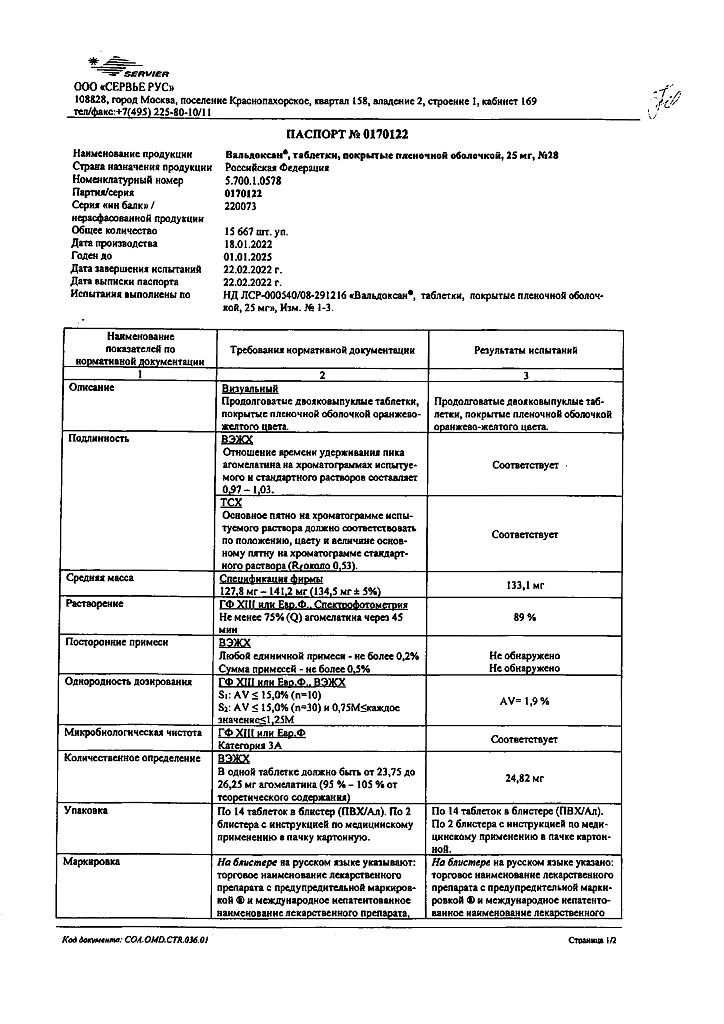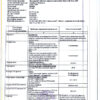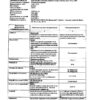No products in the cart.
Valdoxan, 25 mg 28 pcs
€50.99 €42.49
Description
Agomelatine is a melatoninergic MT1 and MT2 receptor agonist and serotonin 5-HT2C receptor antagonist. Agomelatine is an antidepressant active in validated models of depression (acquired helplessness test, despair test, moderate chronic stress), as well as in models with desynchronization of circadian rhythms, and in experimental situations of anxiety and stress. Agomelatine has not been shown to affect monoamine uptake and has no affinity for alpha-, beta-adrenergic, histaminergic, cholinergic, dopaminergic and benzodiazepine receptors.
Agomelatine increases the release of dopamine and norepinephrine, especially in the prefrontal cortex and does not affect the concentration of extracellular serotonin. In experiments on animals with desynchronization of circadian rhythms it was shown that agomelatine restores synchronization of circadian rhythms through stimulation of melatonin receptors.
Agomelatine helps to restore normal sleep patterns.
Agomelatine short-term use (therapy for 6-8 weeks) in doses of 25-50 mg has been shown to be effective in patients with major depressive episodes.
Agomelatine has also been shown to be effective in patients with more severe forms of depressive disorder (Hamilton scale score >25). Agomelatine was also effective in initially high levels of anxiety, as well as in combinations of anxiety and depressive disorders.
The maintenance antidepressant effect of agomelatine (with a study duration of 6 months) at a dose of 25-50 mg once daily was confirmed. The results of the study confirmed the antidepressant efficacy of agomelatine, as assessed by time to relapse (p = 0.0001). The relapse rate in the group of patients taking agomelatine was 22%, while in the placebo group it was 47%.
The efficacy of agomelatine has been demonstrated in six of seven clinical trials (advantage (2 studies), or comparable efficacy (4 studies)) in heterogeneous adult patient populations with depression, compared with SSRIs/ SSRIs (sertraline, escitalopram, fluoxetine, venlafaxine or duloxetine). The antidepressant effect was assessed using the Hamilton scale (17-item version) as either the primary or secondary endpoint.
Agomelatine has no adverse effect on attention or memory; in depressed patients, agomelatine at a dose of 25 mg increases the duration of the slow sleep phase without changing the number or duration of the fast sleep phases. Agomelatine 25 mg also promotes faster onset of sleep with a decrease in heart rate and improved quality of sleep (from the first week of treatment); no daytime retardation is noted.
Agomelatine tends to reduce the frequency of sexual dysfunction (effect on arousal and orgasm).
Taking agomelatine has no effect on heart rate and blood pressure, does not cause sexual disorders, does not cause “withdrawal” syndrome (even with abrupt termination of treatment) and “addiction” syndrome. The efficacy of agomelatine at a dose of 25-50 mg once daily has been confirmed in elderly depressed patients younger than 75 years in an 8-week clinical trial. There is no confirmed evidence of a significant effect in patients 75 years of age or older.
The tolerability of agomelatine in elderly patients is comparable to that in younger patients. In a 3-week, controlled study involving patients with major depressive disorder with insufficient therapeutic effect from paroxetine (SSRIs) or venlafaxine (SSRIs), withdrawal syndrome was observed when switching from therapy with these antidepressants to agomelatine treatment.
The withdrawal syndrome occurred both after discontinuation of previously prescribed SSRIs/ SSRIs and with their gradual withdrawal, which may have been mistaken for the low efficacy of agomelatine at baseline.
The number of patients who experienced at least one symptom associated with withdrawal after one week of SSRI/ SSRI withdrawal was lower in the long-term dose reduction group (gradual dose reduction of SSRIs/ SSRIs over 2 weeks) than in the rapid dose reduction group (gradual dose reduction of SSRIs/ SSRIs over 1 week) and than in one-step withdrawal: 56.1%, 62.6%, and 79.8% of patients, respectively.
Pharmacokinetics
Absorption and bioavailability
Agomelatine is rapidly (>80%) absorbed after oral administration. Peak plasma concentrations are reached 1-2 hours after oral administration. Absolute bioavailability after therapeutic dose is low (<5%); interindividual variability is significant. Bioavailability in women is higher than in men. Bioavailability increases while taking oral contraceptives and decreases while smoking.
When administering therapeutic doses, the maximum concentration of the drug increased in proportion to the dosage. A more pronounced effect of first passage through the liver was noted with higher doses. Food intake (both regular and high-fat) had no effect on bioavailability or absorption. Interindividual variability was increased with high-fat dietary intake.
Distribution
Volume of distribution in equilibrium phase was about 35 l.
Binding to plasma proteins – 95% regardless of the drug concentration, age or presence of renal failure. In case of hepatic insufficiency a twofold increase of free fraction of the drug was noted.
Biotransformation
After oral administration agomelatine undergoes rapid oxidation, mainly due to CYP1A2 and CYP2C9 isoenzymes. CYP2C19 isoenzyme is also involved in agomelatine metabolism, but its role is less significant.
The main metabolites in the form of hydroxylated and demethylated agomelatine are inactive, rapidly bound and excreted by the kidneys.
Excretion
Excretion is rapid. The plasma elimination half-life is 1 to 2 hours. Metabolic clearance is about 1100 ml/min. Excretion is mainly by the kidneys (80%) as metabolites. The amount of unchanged drug in urine is insignificant. The kinetics does not change if the drug is repeatedly administered.
Renal impairment
In patients with severe renal impairment, the pharmacokinetic parameters were not significantly altered when agomelatine was administered in a single dose of 25 mg. Because of limited clinical experience, caution should be exercised when prescribing agomelatine in patients with moderate to severe renal impairment.
Hepatic failure
. In patients with mild (Child-Pugh Class A) and moderate (Child-Pugh Class B) chronic hepatic impairment with cirrhosis, agomelatine at a dose of 25 mg was associated with increases in plasma concentrations of 70 and 140 times, respectively, when compared to volunteers of comparable sex, age and smoking status but without hepatic impairment.
Elderly Patients
When agomelatine was administered at a dose of 25 mg to elderly patients aged 65 years and older, it was observed that the mean AUC and mean maximum concentration were 4 times and 13 times higher, respectively, in patients aged 75 years and older, compared with patients younger than 75 years. The total number of patients receiving 50 mg was too low to draw any conclusions. No dose adjustment based on age was necessary.
Raciality
There are no data on racial differences in pharmacokinetic parameters.
Indications
Indications
Treatment of major depressive disorder.
Pharmacological effect
Pharmacological effect
Agomelatine is an agonist of melatonergic receptors MT1 and MT2 and an antagonist of serotonin 5-HT2C receptors. Agomelatine is an antidepressant active in validated models of depression (learned helplessness test, despair test, moderate chronic stress), as well as in models with desynchronization of circadian rhythms, as well as in experimental situations of anxiety and stress. Agomelatine has been shown to have no effect on monoamine uptake and has no affinity for alpha, beta adrenergic, histaminergic, cholinergic, dopaminergic and benzodiazepine receptors.
Agomelatine enhances the release of dopamine and norepinephrine, especially in the prefrontal cortex and does not affect the concentration of extracellular serotonin. In animal experiments with circadian rhythm desynchronization, agomelatine has been shown to restore circadian rhythm synchronization through stimulation of melatonin receptors.
Agomelatine helps restore normal sleep structure. decrease in body temperature and release of melatonin.
The effectiveness of short-term use of agomelatine (therapy for 6-8 weeks) in doses of 25-50 mg in patients with major depressive episodes has been shown.
The use of agomelatine has also been shown to be effective in patients with more severe forms of depressive disorder (Hamilton scale score >25). Agomelatine was also effective for initially high levels of anxiety, as well as for combined anxiety and depressive disorders.
The supportive antidepressant effect of agomelatine was confirmed (with a study duration of 6 months) at a dose of 25-50 mg once a day. The results of the study confirmed the anti-relapse effectiveness of agomelatine, which was assessed by the time to disease relapse (p = 0.0001). The relapse rate in the group of patients taking agomelatine was 22%, in the placebo group – 47%.
The efficacy of agomelatine was demonstrated in six of seven clinical studies (benefit (2 studies), or comparable efficacy (4 studies)) in heterogeneous populations of adult patients with depression, compared with SSRIs/SNRIs (sertraline, escitalopram, fluoxetine, venlafaxine or duloxetine). Antidepressant effect was assessed using the Hamilton scale (17-item version) as either a primary or secondary endpoint.
Agomelatine does not have a negative effect on alertness and memory; in patients with depression, agomelatine at a dose of 25 mg increases the duration of the slow-wave sleep phase without changing the number and duration of REM sleep phases. Taking agomelatine at a dose of 25 mg also promotes a faster onset of sleep with a decrease in heart rate and improved sleep quality (starting from the first week of treatment); however, there is no inhibition during the daytime.
While taking agomelatine, there was a tendency to reduce the frequency of sexual dysfunction (impact on arousal and orgasm).
Taking agomelatine does not affect heart rate and blood pressure, does not cause sexual dysfunction, does not cause “withdrawal” syndrome (even with abrupt cessation of treatment) and “addiction” syndrome. The effectiveness of agomelatine at a dose of 25-50 mg once daily was confirmed in elderly depressed patients under 75 years of age during an 8-week clinical trial. There is no evidence of a significant effect in patients aged 75 years and older.
The tolerability of agomelatine in elderly patients is comparable to that in young patients. In a 3-week, controlled study of patients with major depressive disorder who were not responding to paroxetine (SSRI) or venlafaxine (SNRI), withdrawal syndrome was observed when switching from these antidepressants to agomelatine.
Withdrawal syndrome appeared both after immediate cessation of treatment with previously prescribed SSRIs/SNRIs, and during their gradual withdrawal, which could be mistakenly taken as a manifestation of the low effectiveness of agomelatine at the initial stage of treatment.
The number of patients who experienced at least one withdrawal symptom 1 week after discontinuation of an SSRI/SNRI was lower in the long-dose taper group (SSRI/SNRI taper over 2 weeks) than in the rapid taper group (SSRI/SNRI taper over 1 week), and than in the immediate taper group: 56.1% 62.6% and 79.8% of patients, respectively.
Pharmacokinetics
Absorption and bioavailability
After oral administration, agomelatine is rapidly (>80%) absorbed. Peak plasma concentrations are reached 1-2 hours after oral administration. Absolute bioavailability after taking a therapeutic dose is low (<5%); interindividual variability is significant. Bioavailability is higher in women than in men. Bioavailability increases with oral contraceptives and decreases with smoking.
When prescribing therapeutic doses, the maximum concentration of the drug increased in proportion to the dosage. When taking higher doses, a more pronounced first-pass effect through the liver was observed. Meal intake (both regular and high-fat) did not affect either bioavailability or extent of absorption. Interindividual variability increased when eating a high-fat diet.
Distribution
The volume of distribution in the equilibrium phase was about 35 liters.
Plasma protein binding is 95%, regardless of drug concentration, age or the presence of renal failure. In case of liver failure, a twofold increase in the free fraction of the drug was observed.
Biotransformation
After oral administration, agomelatine undergoes rapid oxidation, mainly due to the isoenzymes CYP1A2 and CYP2C9. The CYP2C19 isoenzyme is also involved in the metabolism of agomelatine, but its role is less significant.
The main metabolites in the form of hydroxylated and demethylated agomelatine are inactive, quickly bind and are excreted by the kidneys.
Removal
Elimination occurs quickly. The plasma half-life is 1 to 2 hours. Metabolic clearance is approximately 1100 ml/min. Excretion occurs mainly by the kidneys (80%) in the form of metabolites. The amount of unchanged drug in the urine is insignificant. When the drug is re-administered, the kinetics do not change.
Kidney failure
In patients with severe renal failure, a single dose of agomelatine at a dose of 25 mg did not significantly change the pharmacokinetic parameters. Due to limited clinical experience, caution should be exercised when prescribing agomelatine to patients with moderate to severe renal impairment.
Liver failure
When agomelatine was administered at a dose of 25 mg to patients with mild (Child-Pugh class A) and moderate (Child-Pugh class B) chronic liver failure due to liver cirrhosis, an increase in its plasma concentration was noted by 70 and 140 times, respectively, compared with volunteers matched by gender, age and smoking status, but without liver failure.
Elderly patients
When agomelatine 25 mg was administered to elderly patients aged 65 years and older, it was noted that the mean AUC and mean maximum concentration were 4-fold and 13-fold higher, respectively, in patients aged 75 years and older compared with patients younger than 75 years. The total number of patients receiving 50 mg was too low to draw any conclusions. No dose adjustment is required depending on age.
Race
There are no data on racial differences in pharmacokinetic parameters.
Special instructions
Special instructions
Liver function monitoring:
Cases of liver damage, including liver failure (leading in exceptional cases to death or requiring liver transplantation in patients with pre-existing risk factors for liver damage), increases in liver enzymes more than 10 times the upper limit of normal, hepatitis and jaundice have been reported in patients taking Valdoxan® in the post-marketing period. Most of these disorders occurred in the first months of treatment. The nature of liver damage appears to be primarily hepatocellular. As a rule, after cessation of therapy, transaminase levels returned to normal values.
Caution should be exercised before starting treatment and close monitoring during treatment in all patients, especially those with risk factors for liver disease or those receiving concomitant therapy with drugs that can cause liver damage.
Before starting therapy
Treatment with Valdoxan® should be prescribed only after a careful assessment of the ratio of expected benefit to possible risk in patients with risk factors for developing liver dysfunction, such as:
obesity/overweight/non-alcoholic fatty liver disease, diabetes,
alcoholism and/or alcohol abuse;
and taking medications that can cause liver dysfunction.
Before initiating therapy, liver function tests should be performed in all patients, and therapy cannot be initiated if AJIT and/or AST liver enzyme levels are more than 3 times the upper limit of normal. Caution should be exercised when prescribing Valdoxan® to patients with initially elevated transaminase activity (above the upper limit of normal, but not more than 3 times the upper limit of normal).
Frequency of liver function tests
Before starting therapy
And further:
in approximately 3 weeks,
after approximately 6 weeks (end of the stopping period of therapy),
after approximately 12 and 24 weeks (end of the maintenance period of therapy)
in the future – in accordance with the clinical situation.
When increasing the dose, liver function should be monitored at the same frequency as at the beginning of therapy.
If the activity of transaminases in the blood serum increases, a repeat test should be performed within 48 hours.
During treatment
Treatment with Valdoxan® should be stopped immediately if:
symptoms and signs of possible liver dysfunction (such as dark urine, discolored stools, yellow skin/eyes, pain in the right upper abdomen, new persistent and unexplained fatigue).
an increase in transaminase levels more than 3 times compared to the upper limit of normal.
After discontinuation of therapy with Valdoxan®, liver function tests should be performed regularly until transaminase levels normalize.
Elderly patients
The effectiveness of the drug in elderly patients (aged 75 years and older) has not been established. In this regard, Valdoxan® should not be prescribed to patients in this age group.
Elderly patients with dementia
Valdoxan® should not be prescribed for the treatment of major depressive episodes in elderly patients with dementia (due to the lack of data on the effectiveness and safety of the drug in this group of patients).
Patients with kidney failure
In patients with severe renal failure, no significant changes in pharmacokinetic parameters were observed. However, experience with the use of Valdoxan® for major depressive episodes in patients with moderate to severe renal failure is limited. When prescribing Valdoxan® to such patients, caution should be exercised.
Bipolar disorders/mania/hypomania
Caution should be exercised when using Valdoxan® in patients with a history of bipolar disorders, manic or hypomanic episodes. If symptoms of mania appear, you should stop taking the drug.
Suicide/suicidal behavior
People who are depressed have an increased risk of suicidal ideation, self-harm, and suicide (suicide-related events). The risk remains until a clear remission occurs. Patients should be under medical supervision until the condition improves (after starting therapy, it may take several weeks for the condition to improve). Clinical experience suggests that the risk of suicide may increase in the early stages of remission.
Patients with a history of events associated with suicide, as well as patients who had suicidal intentions before starting therapy, are at risk and should be under close medical supervision during therapy.
The results of a meta-analysis of clinical trials of antidepressants in patients with mental disorders indicate an increased risk of suicidal behavior in patients under 25 years of age while taking antidepressants compared with placebo.
During the treatment period, patients, especially those at risk, should be under close medical supervision, especially at the beginning of therapy and when changing the dose of the drug. Patients (and their caregivers) should be advised to seek immediate medical attention if their condition worsens, if they experience suicidal or unusual behavior, or if they experience suicidal thoughts.
Combined use with CYP1A2 isoenzyme inhibitors
Caution should be exercised when using agomelatine simultaneously with moderate inhibitors of the CYP1A2 isoenzyme (such as propranolol, enoxacin) due to the possibility of increasing the concentration of agomelatine.
Patients with lactose intolerance
The drug should not be used in patients with lactose intolerance: lactase deficiency, galactosemia and glucose-galactose malabsorption.
Impact on the ability to drive vehicles and machinery
No studies have been conducted to study the effect of Valdoxan® on the ability to drive a car or use other mechanisms. It should be remembered that dizziness and drowsiness are common side effects of agomelatine.
Active ingredient
Active ingredient
Agomelatine
Composition
Composition
1 tablet contains:
Active substance:
agomelatine 25 mg.
Excipients: lactose monohydrate, magnesium stearate, corn starch, povidone, colloidal silicon dioxide, sodium carboxymethyl starch, stearic acid.
Film coating: glycerol, hypromellose, yellow iron oxide dye, macrogol 6000, magnesium stearate, titanium dioxide.
Pregnancy
Pregnancy
Little experience with the use of agomelatine in pregnant women has not shown any side effects on the course of pregnancy, the health of the fetus or newborn. Currently, there is no other epidemiological information on this matter. During pregnancy, the drug should be used with caution and in cases where the expected benefit of therapy for the mother outweighs the potential risk to the fetus.
It is not known whether agomelatine is excreted in human breast milk. If it is necessary to use Valdoxan during lactation, breastfeeding should be discontinued.
Experimental studies on animals did not reveal any direct or indirect harmful effects of the drug on pregnancy, embryonic or fetal development, labor or postnatal development. Agomelatine and its metabolites have been shown to be excreted in breast milk in rats.
Little experience with the use of agomelatine in pregnant women has not shown any side effects on the course of pregnancy, the health of the fetus or newborn. Currently, there is no other epidemiological information on this matter. During pregnancy, the drug should be used with caution and in cases where the expected benefit of therapy for the mother outweighs the potential risk to the fetus.
It is not known whether agomelatine is excreted in human breast milk. If it is necessary to use Valdoxan during lactation, breastfeeding should be discontinued.
Experimental studies on animals did not reveal any direct or indirect harmful effects of the drug on pregnancy, embryonic or fetal development, labor or postnatal development. Agomelatine and its metabolites have been shown to be excreted in breast milk in rats.
Contraindications
Contraindications
Hypersensitivity to agomelatine and/or any of the excipients of the drug.
Liver failure (for example, cirrhosis or active liver disease) or an increase in transaminase levels more than 3 times the upper limit of normal.
Concomitant use of potent inhibitors of the CYP1A2 isoenzyme (such as fluvokeamine, ciproflokeacin).
Children under 18 years of age (due to lack of sufficient experience in clinical use). In children and adolescents taking other antidepressants, suicidal behavior (suicide attempts and suicidal thoughts) and hostility (mainly aggressiveness, conflict behavior, irritation) were observed more often compared to the placebo group.
The drug should not be used in patients with lactose intolerance: lactase deficiency, galactosemia and glucose-galactose malabsorption.
Precautions for use
Patients with moderate to severe renal failure in the treatment of major depressive episodes, while co-prescribing agomelatine with moderate inhibitors of the CYP1A2 isoenzyme (such as propranolol, enoxacin), patients with a history of manic or hypomanic episodes, patients with a history of events associated with suicide, as well as patients who had suicidal intentions before starting therapy.
Caution should be exercised when prescribing the drug to patients who abuse alcohol or take drugs that can cause liver dysfunction.
Side Effects
Side Effects
In clinical studies, Valdoxan® was administered to more than 8,000 patients with depression.
Side effects were most often mild or moderate and were observed in the first two weeks of treatment. The most frequently reported symptoms were headache, nausea and dizziness. The observed side effects were usually transient and generally did not require discontinuation of treatment. Below are data on side effects observed in placebo-controlled and comparative clinical studies.
The frequency of side effects of agomelatine is given in the following gradation: very often (>1/10), often (>1/100, 1/1000, 1/10000, <1/1000); very rare (<1/10000), unspecified frequency.
From the central nervous system:
Very common: headache
Common: dizziness, drowsiness, insomnia.
Uncommon: migraine, paresthesia, restless legs syndrome*.
Rare: akathisia*.
From the gastrointestinal tract:
Common: nausea, diarrhea, constipation, abdominal pain, vomiting*.
Disorders of the liver and biliary tract:
Common: increased AJIT and/or ACT activity (more than 3 times the upper limit of normal in 1.2% of patients receiving agomelatine 25 mg per day and in 2.6% of patients receiving agomelatine 50 mg per day, compared with 0.5% receiving placebo in clinical studies).
Uncommon: increased γ-glutamyltransferase* (GGT) activity (more than 3 times the upper limit of normal)
Rarely: hepatitis, increased alkaline phosphatase* activity (more than 3 times the upper limit of normal), liver failure*(1), jaundice*.
From the skin and subcutaneous tissue:
Uncommon: sweating, eczema, itching*, urticaria*.
Rarely: erythematous rash, facial swelling and angioedema*.
On the part of the hearing organ:
Uncommon: tinnitus*.
From the side of the organ of vision:
Uncommon: blurred vision.
From the musculoskeletal system:
Common: back pain.
Renal and urinary tract disorders:
Rarely: urinary retention*.
Common disorders:
Common: fatigue.
Mental disorders
Common: anxiety, unusual dreams*.
Uncommon: suicidal thoughts or behavior, agitation and related symptoms* (such as irritability and restlessness), aggression*, nightmares*, mania/hypomania* (these symptoms may also be a manifestation of an underlying medical condition), confusion*.
Rarely: Hallucinations*.
Data from (additional) surveys
Common: weight gain*.
Uncommon: weight loss*.
* The frequency of adverse reactions identified by spontaneous reports was assessed based on clinical trial data.
(1) Only a few cases of death or liver transplantation have been reported in patients with preexisting risk factors for liver disease.
Interaction
Interaction
Potential influence of other medicinal products
Agomelatine is metabolized 90% in the liver with the participation of cytochrome P450 1A2 (CYP1A2) and 10% by CYP2C9/19. Therefore, any drugs whose metabolism depends on these isoenzymes may increase or decrease the bioavailability of agomelatine.
Fluvoxamine is a strong inhibitor of the CYP1A2 isoenzyme and a moderate inhibitor of the CYP2C9 isoenzyme and significantly slows down the metabolism of agomelatine, while the concentration of agomelatine increases on average 60 (12 – 412) times. Therefore, the simultaneous use of agomelatine and strong inhibitors of the CYP1A2 isoenzyme (such as fluvoxamine, ciprofloxacin) is contraindicated. The simultaneous administration of agomelatine and estrogens, which are moderate inhibitors of the CYP1A2 isoenzyme, leads to an increase in the concentration of agomelatine several times. Although the combined use of agomelatine and estrogens was not accompanied by a deterioration in the safety profile of the therapy, caution should be exercised when co-prescribing agomelatine with other moderate inhibitors of the CYP1A2 isoenzyme (such as propranolol, enoxacin) until sufficient clinical experience has been gained (see section “Special Instructions”).
Rifampicin, as an inducer of all three isoenzymes involved in the metabolism of agomelatine, may reduce the bioavailability of agomelatine.
It has been shown that smoking, by inducing the CYP1A2 isoenzyme, reduces the bioavailability of agomelatine, especially in patients who smoke excessively (>15 cigarettes/day).
Potential effects of agomelatine on other medicinal products
In vivo, agomelatine does not induce cytochrome P450 isoenzymes. Agomelatine does not inhibit the CYP1A2 isoenzyme in vivo or other cytochrome P450 isoenzymes in vitro.
Therefore, agomelatine does not affect the concentration of drugs whose metabolism is associated with these isoenzymes.
Drugs that are significantly bound to plasma proteins Agomelatine did not change the free concentration of drugs that are significantly bound to plasma proteins and, in turn, they did not affect the concentration of agomelatine.
Other medicines
No pharmacokinetic and pharmacodynamic interactions have been identified between agomelatine and drugs commonly used in the target patient population: benzodiazepines, lithium drugs, paroxetine, fluconazole and theophylline.
Alcohol
The use of agomelatine with alcohol is not recommended.
Electroconvulsive therapy (ECT)
There are no data on the use of agomelatine concomitantly with ECT. Since agomelatine did not cause seizures in animal studies, adverse effects from the combined use of agomelatine and ECT seem unlikely.
Overdose
Overdose
Data on agomelatine overdose are limited.
Symptoms: drowsiness, epigastric pain, restlessness, weakness, anxiety, agitation, tension, dizziness, cyanosis, malaise.
When the patient took agomelatine at a dose of 2450 mg, the condition returned to normal independently, without disturbances in the cardiovascular system or changes in laboratory parameters.
Treatment: Specific antidotes for agomelatine are not known. Symptomatic treatment and monitoring in specialized departments with follow-up.
Storage conditions
Storage conditions
No special storage conditions required
Shelf life
Shelf life
3 years
Manufacturer
Manufacturer
Servier Rus LLC, Russia
Additional information
| Shelf life | 3 years |
|---|---|
| Conditions of storage | No special storage conditions required |
| Manufacturer | Servier Rus LLC, Russia |
| Medication form | pills |
| Brand | Servier Rus LLC |
Related products
Buy Valdoxan, 25 mg 28 pcs with delivery to USA, UK, Europe and over 120 other countries.




















